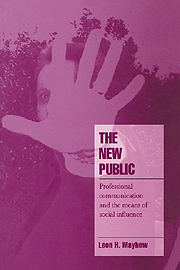Book contents
- Frontmatter
- Contents
- Preface
- Part I Rhetoric and the integration of society
- Part II Influence
- Part III The New Public
- 7 The emergence of the New Public: advertising, market research and public relations
- 8 Political communication in the New Public
- 9 Forums for the redemption of influence
- 10 The rhetoric of presentation
- Notes
- References
- Index
9 - Forums for the redemption of influence
Published online by Cambridge University Press: 06 September 2009
- Frontmatter
- Contents
- Preface
- Part I Rhetoric and the integration of society
- Part II Influence
- Part III The New Public
- 7 The emergence of the New Public: advertising, market research and public relations
- 8 Political communication in the New Public
- 9 Forums for the redemption of influence
- 10 The rhetoric of presentation
- Notes
- References
- Index
Summary
The dominance of professional institutions of public communication has a crucial effect on rhetoric and influence in contemporary public life. Rhetoric takes linguistic and social forms that lead to the inflation of influence, not just the overstatement typically connoted today by the very word “rhetoric,” but a chronic, socially structured inflation produced by the dissociation of public discussion and underlying issues of public concern. The issues discussed in debates readily accessible to the public at large – campaign debates, for example – often fail to evoke and to aggregate the solidarities of groups whose socially grounded backing could bring about new, realistic, problem-oriented policies.
Contemporary rhetoric and the inflation of influence
Sources of the inflation of influence. Four rhetorical practices dissociate public deliberation from the structure of social life: lack of meaningful policy issues on the public agenda; appeals to attitudes that do not tap structures of solidarity that could support effective responses to social problems; one-sided communication that fails to provide opportunities for demands that claims be redeemed in discourse; evasive, strategic responses that attempt to spin rhetorical descriptions rather than to supply straight-forward answers to queries and objections.
The first type of dissociation occurs when broad symbols of generalized attitudes are merely displayed rather than explicated. Dissociated symbols have only weak ties to authentic issues of public policy, as in the case of the famous Bush television spot of 1988 showing a black prisoner moving around a revolving door.
- Type
- Chapter
- Information
- The New PublicProfessional Communication and the Means of Social Influence, pp. 236 - 268Publisher: Cambridge University PressPrint publication year: 1997



